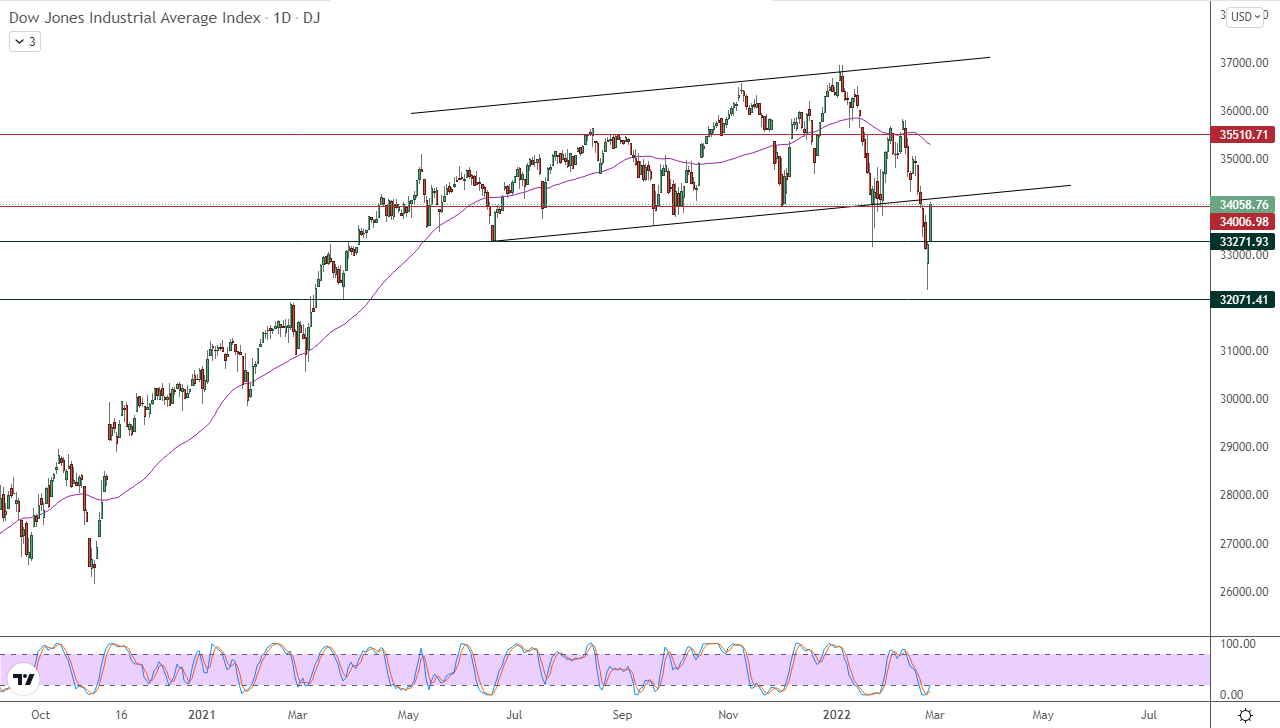The Dow Jones Industrial Average rose in the green color during its recent trading at the intraday levels, to achieve sharp gains for the second day in a row, by 2.51%. It gained about 834.92 points and settled at the end of trading at the level of 34,058.76. This happened after rising in trading Thursday by 0.28 %, during the past week and the index declined slightly by -0.06%, after hitting its lowest level during the week at 32,272.64, to rebound from it to decrease its losses.
All 30 components of the index rose, led by a percentage gainer, Johnson & Johnson, by 4.97%, and 3M Co. by 4.74%, followed by UnitedHealth Group Inc. By 4.36%.
Stocks rallied last week despite Russia's invasion of Ukraine, as the threat of an offensive lingered to pressure markets for weeks, so the actual start of the war may have shifted investors' focus to the chances of a solution. Clearly some traders are betting that the Fed will slow down its tightening in response, giving riskier assets a chance to go higher.
There have been reports that Russia supports talks with the Ukrainian leadership. However, the Russian military appeared at the same time as it was pressing towards the Ukrainian capital.
US economic data released on Friday showed that Americans sharply increased spending by 2.1% in January, exceeding expectations. While spending fell in December for the first time in 10 months as concerns over the omicron mutant of the coronavirus overshadowed.
Meanwhile, the Fed's preferred inflation index rose 0.6% in January and showed the largest annual increase since 1982, underlining why the central bank is ready to raise interest rates for the first time in four years.
In other economic data, the government said on Friday that durable goods orders rose 1.6% in January. Economists expected a 0.8% rise in orders for durable goods, which are products made to last at least three years.
The final reading of US Consumer Confidence for February from the University of Michigan rose slightly to 62.8, and the index hit 61.7 earlier in the month after an initial survey, hitting its lowest level in more than 10 years.
US pending home sales fell 5.7% in January, according to a monthly index released by the National Association of Realtors on Friday. Economists polled by the Wall Street Journal expected pending home sales to rise 1%.
Technically, the index with its recent rise is trying to compensate for part of what it incurred from previous losses. At the same time, it tried to drain some of its clear oversoldness with the relative strength indicators, especially with the beginning of a positive crossover in them, to retest the main resistance level 34,000.
This is in light of the dominance of a bearish corrective wave in the short term, with the negative pressure continuing for its trading below the simple moving average for the previous 50 days, as shown in the attached chart for a (daily) period.
Therefore, we expect the index to return to decline during its upcoming trading, as long as the resistance 34,000 remains, to target the support level 33,271.93.

